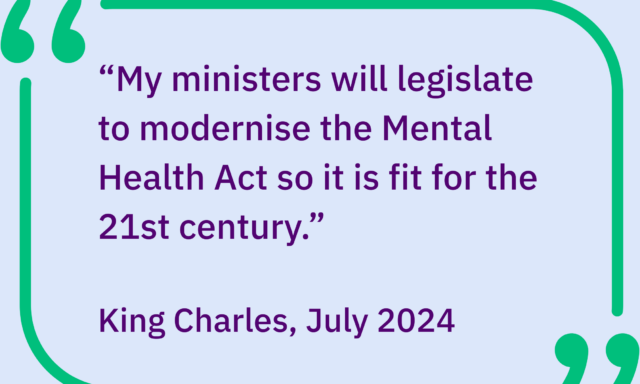The pendulum swings: why NHS leaders can’t afford to repeat 2007 Mental Health Act mistakes
02 June 2025

What did the 2007 Mental Health Act really change and why should NHS leaders pay attention as history risks repeating itself? As the Mental Health Bill 2025 moves closer to becoming law, many within the system remain underprepared for what its implementation will demand.
Legal expert Tim Spencer-Lane views the last major legislative overhaul in 2007 as a clear warning. The trajectory of mental health law, he said, is like a pendulum. In 2007, it swung firmly in the direction of public protection. Now, it is moving decisively towards patient individual autonomy and rights. However, as Spencer-Lane warned, any significant change to the legal framework will bring disruption if those responsible for delivery failed to engage early or fully.
2007: a shift to public protection
Spencer-Lane pointed to the reforms made in 2007 to illustrate what happens when systemic change meets limited preparedness. The introduction of Community Treatment Orders (CTOs) was, in his view, the defining feature of the 2007 changes. Designed in part as a response to the high-profile killing of Jonathan Zito by a man with schizophrenia, CTOs were born from political pressure to ensure that people discharged from hospital could be more tightly supervised in the community.
The new powers allowed clinicians to set specific conditions on discharged patients, such as where they lived or received treatment, and recall them to hospital if their condition deteriorated. The legislation assumed that clinical teams would adapt, but this overlooked how much of the delivery would fall to stretched community and crisis teams. Spencer-Lane noted that CTOs fundamentally reweighted the balance of responsibility away from inpatient units and onto community infrastructure, and that the service landscape was never adequately prepared for that shift.
A quiet clause that reshaped practice
He also recalled the significant impact of the Deprivation of Liberty Safeguards (DoLS), which were inserted into the Mental Capacity Act via the 2007 reforms. At the time, these safeguards attracted little debate in Parliament or the wider sector. Yet they would go on to underpin a whole new regime of legal authorisation of deprivation of liberty for people lacking capacity, in care homes and hospital settings. While only around 50,000 people are detained each year under the Mental Health Act, DoLS now apply to more than 300,000 individuals annually. The change stemmed from the landmark Bournewood case, where the European Court of Human Rights ruled that admitting someone informally to hospital, despite their lack of capacity and compliance, could still amount to a deprivation of liberty. The UK government responded by creating a new legal framework to cover compliant yet incapacitated patients, but Spencer-Lane said the scale of this framework, and the bureaucratic burden it placed on public bodies and providers, was vastly underestimated at the time. To some degree, the vast numbers could not be predicted as they were due to the 2014 Supreme Court decision known as Cheshire West, but even before then there were signs that the system was struggling to cope.
A broadened net for detention
Alongside these headline changes, the 2007 reforms also redrew the foundations of the detention criteria. The treatability test was abolished, replaced with a requirement for “appropriate medical treatment”, a move designed to allow for greater use of the Act in cases such as personality disorder. This, Spencer-Lane explained, was largely a response to political pressure following the Michael Stone case. Stone, who had a diagnosis of antisocial personality disorder, was found guilty of murder in 1996. Public and political reaction centred on whether he could and should have been detained prior to the incident. The government’s position was that clinical services had failed to act, and the 2007 Act was in part a legal mechanism to encourage more assertive use of compulsory powers.
The reshaping of the clinical roles defined under the Act also had lasting consequences. The creation of the Approved Mental Health Professional (AMHP) role opened up responsibilities previously reserved for social workers to other professions, such as nurses and occupational therapists. The definition of “responsible clinician” was broadened as well. Spencer-Lane believed these were among the more successful changes, pushing mental health care into a genuinely multidisciplinary space. But again, the system was left largely to adapt in real time, without a structured national support offer.
A climate of scepticism and missed opportunity
Reflecting on the implementation period that followed, Spencer-Lane described a sector unsure whether the reforms would even materialise. After two previous attempts by the Blair government to replace the Mental Health Act had failed amid stakeholder backlash, the final iteration landed in a climate of fatigue. This scepticism translated into patchy preparation. Services delayed planning in the hope that political pressure might scupper the Bill. When it did pass, a critical window for practical readiness had already been missed.
It is also vital that there should not be a policy vacuum. The Code of Practice should be consulted on and revised as soon as practicable. This may be tricky given that many of the reforms will be brought into force at a later date. But with no full and detailed statutory guidance during the early implementation phase, there may be considerable inconsistency in how the provisions are applied on the ground. Practitioners need full confidence and understanding of how the new powers should be implemented.
A lack of scrutiny that must not be repeated
The lack of scrutiny around implementation was another theme that Spencer-Lane said must not be repeated. He highlighted the lack of formal monitoring into how effectively the 2007 reforms had been embedded, such as by a post-legislative parliamentary scrutiny committee. . In the case of CTOs, peers and practitioners alike have pointed to a gap between the intended use, namely a short-term, last-resort supervision, and the reality. Many CTOs have become long-term tools, used more widely than originally envisaged, especially among patients from Black and minority ethnic backgrounds. Despite this, official monitoring of the Act’s effectiveness has been minimal.
2025: a different policy direction but familiar risks
Looking ahead to the 2025 Bill, Spencer-Lane sees stark contrasts in tone and intention. Whereas the 2007 Act encouraged clinicians to use the Mental Health Act more frequently, the current reforms establish greater rights for patients. The proposed changes seek to tighten detention criteria, promote shared decision-making, and reinforce capacity-based care. In principle, this aligns better with the values and instincts of today’s workforce. However, it places even greater emphasis on the ability of community services to step in with timely, appropriate support.
The challenge is that the resourcing required to underpin this shift is far from guaranteed. Unlike 2007, when budgets were more permissive, the 2025 reforms land in an era of austerity. The government has committed to implementing the Bill only when resources allow, with no detailed timetable or accompanying implementation plan. As a result, it may take years before the provisions come into force — potentially as long as a decade.
New demands on the front line
In the meantime, mental health professionals will need to get to grips with a range of new duties. Spencer-Lane highlighted the increased importance of mental capacity assessments, which are not yet routine across all parts of the system. The introduction of the nominated person will also require a robust communication and sign-off process. There will be more tribunal hearings too, as the periods for automatic reviews shorten. All of this will require significant training and systemic adaptation.
Spencer-Lane was clear: without proper investment and oversight, the risk of disruption is high. NHS leaders would do well to remember the lessons of 2007. Delayed readiness, absent guidance, and limited scrutiny all contributed to a challenging rollout that still casts a shadow over service delivery today. As the pendulum now swings back towards patient rights, the system must not be caught off balance.
2007 reforms: what changed, how unprepared systems struggled, and what NHS leaders should take into 2025
Key changes introduced in 2007:
- Community Treatment Orders (CTOs) gave legal powers to supervise discharged patients in the community
- Deprivation of Liberty Safeguards (DoLS) established a new legal framework under the Mental Capacity Act
- Broader detention criteria allowed more people to be sectioned under the Mental Health Act
- Independent Mental Health Advocates (IMHAs) introduced to support patients’ rights
- AMHP role expanded to include a wider range of professionals beyond social workers
System impacts from poor preparation:
- Services underestimated the operational impact of CTOs, particularly on stretched community and crisis teams
- DoLS introduced a high-volume administrative burden with little initial infrastructure or staffing to manage it
- Training gaps left frontline professionals unsure how to apply new powers or assess eligibility confidently
- Delayed publication of the Code of Practice meant services lacked consistent guidance in early years
- Scepticism about whether the legislation would be implemented led to late-stage planning and disjointed rollout
Lessons for NHS mental health crisis care provider leaders:
- Start readiness planning now, even without fixed implementation dates. Delay will compound disruption later
- Identify and map roles within your service that will be most affected and begin building capability early
- Prioritise workforce upskilling in key areas like capacity assessments, tribunals and nominated person processes
- Create local implementation plans that include governance, communication and service-user engagement
- Work with regional and system partners to stress-test your crisis and community response pathways under the new legal framework
- Use internal audit and quality improvement functions to monitor changes from day one. Do not wait for national oversight


